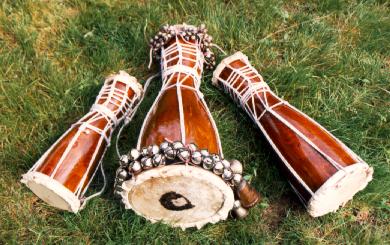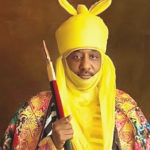The heads are fastened together with leather strips that are wrapped tightly against the body of the drum with other leather strips. The smaller head known as(Sasa) has a metallic, bell – like fixed tone while the bigger head (Oju-Ojo) produce a rounded low tone. When played together they produce a contrasting tone.
Bàtá music popularly called ìlù-Bàtá is best appreciated only when the full ensemble is engaged within its context of performance. Since Bàtá drum was primarily associated with the reign and worship of Sàngó, the pre-modernBàtá ensemble first appeared in a religious worship/setting.
The composition and performance concept of Bàtá drum in Sàngó worship is eroding into an extinct. Basically, the most important contextual usage of Bàtá drum is when the full Bàtá set is performed at Sàngó, Esu and Egúngún religious and semi-religious settings.
Bàtá drum ensemble consists of four to five drums namely;
- The ìyáàlùBàtá – The lead drum (Master drum)
- Omele Abo –- Female accompanying drum
- OmeleAko – Male accompanying drum
- Kúdi – Front guard
- Ejin — Accompaniment drum
Bata drums in Yoruba contemporary music
Several scholarly works have revealed that the immediate changes and developments to traditional musical practices are the basis for contemporary Yoruba music.
It is the period in which new innovations, concepts and ideas in music were adopted through contact with foreign missionaries, transatlantic trade connectivity and most importantly, technological innovations. It was the period of resurgence in art of drumming in which styles and techniques were borrowed from external contact and civilization.
The Introduction of Bàtá drum to social dance music of which requires dissimilar musical background was a remarkable phenomenon. Bàtá drumming assumed enhanced expression, hidden virtues were also discovered and people began to appreciate the intuit intricate values of contemporary Bàtá drummingbetter.
However, the performance-composition for traditional Bàtá music has changed from its original form. More so, the musical nutrients present in Alujo genre of traditional music has been adulterated with agglutination of rhythmic pattern that were adopted from mainstream and urban popular music.
Bata drummers now perform alongside other ‘foreign’ instruments like western ‘Conga and Bongo drums sequenced drums’ thereby assimilating Bàtá drums into other ensemble. The article reveals that the semantic problems in understanding Bata speech tones started as a result of adaptability of Bàtá drum into some other musical genres with an attempt to feature the drum in social/secular ceremonies.
Since performances are out of religious context, the medium and idioms of expression invariably changed into using colloquial and non-sense-cal words as the basis for textual background, unlike rich poetic nature of religious drumming within context.This suggests the semantic inadequacies encountered in Bata drumming.
Moreover, the reasons why practice of using various Western musical elements as an idiom of expression, techniques and communication in Bata drumming is because Bata drums is outside of its natural habitat. The sacredness and the characteristic features of traditional Bàtá drumming began to depreciate in values and originality at the instance of contemporary musical elements. Olaniyan (2007:23) confirms this view when he states that:
The activities of Christian missionaries and those of Islamic religion have influenced the trend of African music immensely. The influence has resulted in the creation of variety of African popular music forms.
These developments also became glaring with the approach of both foreign trained and locally trained educated Nigerian composers in expressing their musical thoughts towards nationalistic movements. They achieve this by using various western musical elements as an idiom of expression.
Western musical instruments like Piano, Organ and Guitar were also blended with traditional instruments. Most churches abolished and abandoned the usages of some traditional instruments especially drums, our indigenous songs were translated to English vis-à-vis western melodies, which greatly distorted their meaning. All these changes were some of the characteristic features of neo-traditional music in Nigeria at large.
The concept of Bàtá music began to change in lieu of the aforementioned external factors that influenced traditional musical practices. Another noticeable feature of Bàtá drumming in neo-traditional music is the adjustment in the structural composition of the ensemble. In traditional settings, OmeleAko was played by a drummer while Kúdi was played by another drummer.
One important reason that comes to mind is that playing OmeleAko alone by a drummer ideally required special undivided attention with the two hands holding the leader straps. The playing device made it possible to fully maximize the art of playing OmeleAko, while the other drummer plays Kúdi with just one hand.
Conversely, the performance-composition for contemporaryBàtá music has a single drummer combining OmeleAko with one Kúdi, this is referred to as ‘OmeleMeji’.
Invariably, the approach to technique of playing is affected. Moreover, the traditional Bàtá music has changed from its original form, the musical nutrients present in Alujo genre of neo-traditional music has been adulterated with agglutination of rhythmic pattern that were adopted from secular music, Islamized music and that of separatist churches.
Pinmiloye O. (2011:208) in a discussion on sematic problem of Bata drumming writes:
The functional roles of the surviving Bàtá drum to the present day’s music are different from that of the Bàtá drumming of the traditional era, even though techniques of playing are almost the same.
In the recent times, some Bàtá drummers in an attempt to supplement the means of livelihood started playing their ‘sacred’ Bàtá drums out of religious contexts. This act subsists as they condescend towards accepting to perform at any kind of secular event/outing.
Not only that,several Bata drummers also perform alongside with other ‘foreign’ instruments like western ‘Conga and Bongo drums’ thereby assimilating Bàtá drums into other ensemble. It is necessary to add that the inception of adaptability of Bàtá drum into some other musical genres had been ever since the olden days when Yoruba people needed to congregate for social/secular ceremonies.
Subsequently, performances are out of religious context, the medium and idioms of expression invariably dewdrop unlike rich poetic nature of religious drumming within context. It is therefore safe to conclude from the foregoing that as long as Bata music is performed outside of context, the source of textual inspiration for Bàtá drumming in contemporary Yoruba music will remain inspired by secular and colloquial lyrics.
All in all, it is obvious from the above characteristic features of contemporary music that the sacredness of Bàtá drumming began to depreciate in values and originality at the instance of overtone with neo-tradition and contemporary music.
It was the period of resurgence in art of Bàtá drumming in which styles and techniques were borrowed from external contact and civilization. Secularization of Bàtá drumming at this period marks the degradation in the psychic power of the Bàtá sound. Neo-tradition or modernity is equally the period in which Bàtá drumming began to be adopted into various profane musical activities outside religious context.
The writer submits that the introduction of Bàtá drum to social dance music of which requires dissimilar musical background was a remarkable phenomenon.Bàtá drumming assumed enhanced expression, hidden virtues were also discovered and people began to appreciate better, the intuit intricate values of Bàtá drumming.






